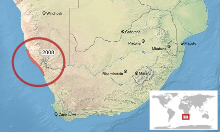Desert rain frog
The desert rain frog, web-footed rain frog, or Boulenger's short-headed frog (Breviceps macrops) is a species of frog in the family Brevicipitidae. It is found in Namibia and South Africa.[1][2][3] Its natural habitat is the narrow strip of sandy shores between the sea and the sand dunes. It is threatened by habitat loss by such factors as mining and tourism.[4]
| Desert rain frog | |
|---|---|
| Scientific classification | |
| Kingdom: | Animalia |
| Phylum: | Chordata |
| Class: | Amphibia |
| Order: | Anura |
| Family: | Brevicipitidae |
| Genus: | Breviceps |
| Species: | B. macrops |
| Binomial name | |
| Breviceps macrops Boulenger, 1907 | |
 | |
Description
The desert rain frog is a small, plump species with bulging eyes, a short snout, short limbs, spade-like feet and webbed toes. On the underside it has a transparent area of skin through which its internal organs can be seen. The size of this frog can span between 4 to 6 centimetres (1.6 to 2.4 in). Its colour is yellowish-brown and often has sand adhering to its skin.[3]
It also has an unusual high-pitched cry similar to that of a squeaky toy.
Unlike most other species of frogs, it develops directly from the egg into adults without passing through the tadpole stage. It has a stout body, with small legs, which makes it unable to hop or leap – instead, it walks around on the sand. The frog does not require water in its habitat to survive. The frog possesses comparatively large bulging eyes.
Habitat
The desert rain frog is mostly found on a small coastal strip of land about 10 kilometres (6.2 mi) wide between the African countries of Namibia and South Africa. The small area of sand dunes often gets a lot of fog, which supplies moisture in an otherwise arid and dry region.
Behavior
The desert rain frog is nocturnal, spending the day in a burrow which is dug to a depth of 10 to 20 centimetres (3.9 to 7.9 in) where the sand is moist. It emerges on both foggy and clear nights and wanders about over the surface of the dunes. Its footprints are distinctive and are often found around patches of dung where it is presumed to feed on moths, beetles and insect larvae. It digs its way into the sand in the morning, and its presence in a locality can be deduced from the little pile of loose sand dislodged by its burrowing activities.[5] Breeding is by direct development of eggs laid in its burrow, and there is no aqueous tadpole stage. It produces a high-pitched squeaking sound when provoked.
Status
The frog's total habitat range is smaller than 2,000 square kilometres (770 sq mi) and is fragmented and the number of individual frogs seems to be decreasing. It is threatened by habitat loss caused by opencast diamond mining and road construction, as well as increased human settlement.
References
- IUCN SSC Amphibian Specialist Group & South African Frog Re-assessment Group (SA-FRoG) (2017). "Breviceps macrops". IUCN Red List of Threatened Species. 2017: e.T3070A2794989. doi:10.2305/IUCN.UK.2017-2.RLTS.T3070A2794989.en.
- Frost, Darrel R. (2019). "Breviceps macrops Boulenger, 1907". Amphibian Species of the World: an Online Reference. Version 6.0. American Museum of Natural History. Retrieved 9 March 2019.
- Castillo, Nery (2011-06-23). "Breviceps macrops". AmphibiaWeb. Retrieved 2012-10-20.
- Channing, Alan; Wahlberg, Kirsty (October 2011). "Distribution and conservation status of the desert rain frogBreviceps macrops". African Journal of Herpetology. 60 (2): 101–112. doi:10.1080/21564574.2011.608383. ISSN 2156-4574.
- Carruthers, V. C. & Passmore, N. I. (1978). "A note on Breviceps macrops Boulenger". Journal of the Herpetological Association of Africa. 18 (1): 13–15. doi:10.1080/04416651.1978.9650950.
External links
- "Desert Rain Frog". Desert Rain Frog - Information, Photos, and Videos.
